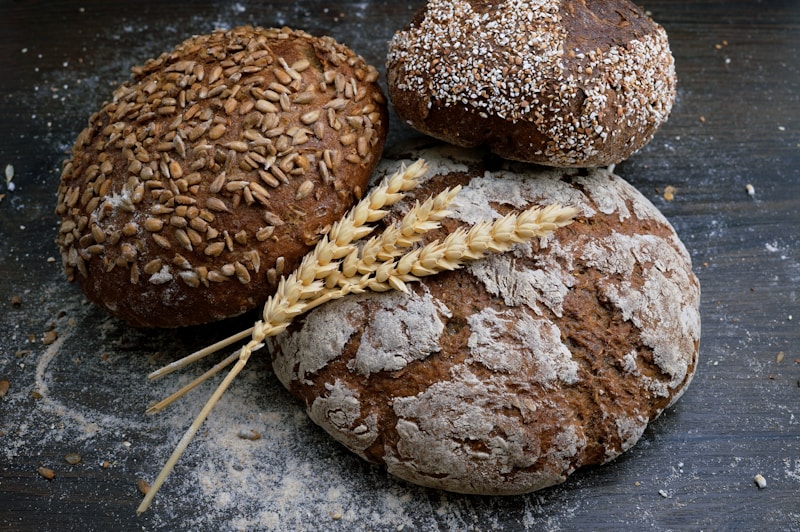12 Questions
Which characteristic is used to categorize bread based on the text?
Shape of the loaf
During which historical period did human ancestors start to domesticate cereal crops for making bread?
Neolithic period
What influenced the production and distribution of bread in the Middle Ages?
Monasteries
What is the key ingredient needed to make bread rise during the baking process?
Yeast
Which of the following is NOT a common ingredient in bread?
Potatoes
What type of bread was likely the first bread made by human ancestors according to the text?
Flat and unleavened
What step in the bread-making process involves allowing yeast to convert sugars into carbon dioxide and ethanol?
Fermentation
Which type of bread is known for its distinctive tangy flavor due to the use of a sourdough culture?
Sourdough
What nutrient can be found in whole grains and multigrain breads that aids digestion and helps lower cholesterol levels?
Fiber
Which bread recipe is characterized by its crusty exterior, airy interior, and long, thin shape?
French baguette
In bread making, what is the purpose of kneading the dough?
To develop gluten for structure and elasticity
Which nutrient is bread primarily composed of and serves as an essential source of energy?
Carbohydrates
Study Notes
Bread: A Timeless Staple
Bread is a staple food that has evolved over thousands of years, serving as a cornerstone of human civilization. From the ancient grains of Mesopotamia to today's diverse loaves, bread continues to be a cherished delicacy in cultures around the world.
Types of Bread
Bread can be categorized based on various characteristics, including:
- Country of origin: French baguettes, Italian focaccia, German rye, and British scones all carry the flavor and tradition of their respective nations.
- Texture and structure: Bread can range from light, airy loaves like French baguettes to dense, chewy breads like sourdough.
- Ingredients: Common ingredients in bread include wheat flour, water, salt, yeast, and sometimes milk, eggs, or sugar. Bread also varies by the type of grain, such as wheat, rye, oat, or corn.
- Shapes: Bread can take various forms, including round loaves, baguettes, rolls, flatbreads, and more.
History of Bread
Breadmaking dates back to the Neolithic period, when human ancestors began to domesticate cereal crops. The first bread was likely flat, unleavened, and cooked directly on a fire. Ancient civilizations like Egypt, Greece, and Rome all embraced bread as a staple food. In the Middle Ages, the rise of monasteries greatly influenced the production and distribution of bread, as monks perfected the art of leavening and baking.
The Bread Making Process
To make bread, a few essential steps are followed:
- Mixing: Ingredients like flour, water, yeast, and salt are combined to form a dough.
- Kneading: The dough is kneaded, usually by hand or with a mixer, to develop gluten, which provides structure and elasticity.
- Fermentation: The dough is left to ferment, allowing yeast to convert sugars into carbon dioxide and ethanol, which causes the dough to rise.
- Shaping: After the dough has risen, it is shaped into the desired form.
- Proofing: The shaped dough is left to rise again, a process called proofing.
- Baking: The dough is placed into a hot oven to bake, causing it to expand and form a crust.
Nutritional Value of Bread
Bread is a good source of carbohydrates and offers a variety of nutrients, such as:
- Carbohydrates: Bread is an essential source of energy, as it is primarily composed of carbohydrates.
- Fiber: Whole grains and multigrain breads are rich in fiber, which aids digestion and helps to lower cholesterol levels.
- Protein: Some breads, such as those made with whole grains and seeds, contain moderate amounts of protein.
- Vitamins and minerals: Bread can be a source of vitamins and minerals like B vitamins, iron, and selenium.
- Fats: Bread generally contains small amounts of fat, but some breads can be higher in fat due to ingredients like nuts, seeds, or added oils.
Bread Recipes
There are countless bread recipes to explore, including:
- Classic white loaf: A basic, versatile bread that can be used for sandwiches or toasts.
- Sourdough: A type of bread made using a fermented dough starter called a sourdough culture, known for its distinctive tangy flavor.
- Focaccia: An Italian bread known for its olive oil-drizzled surface, topped with herbs and vegetables.
- Naan: A flatbread from India, typically cooked in a tandoor oven.
- French baguette: A long, thin loaf of French bread, characterized by its crusty exterior and airy interior.
Bread's history, versatility, and nutritional value make it an essential and cherished food across the world. Whether it's a classic white loaf, a tangy sourdough, or a flavorful focaccia, bread offers endless possibilities for culinary exploration and enjoyment.
Test your knowledge on the history, types, making process, nutritional value, and recipes of bread with this quiz. Explore the diverse world of bread, from French baguettes to sourdough, and learn about the essentials ingredients and techniques used in breadmaking.
Make Your Own Quizzes and Flashcards
Convert your notes into interactive study material.




